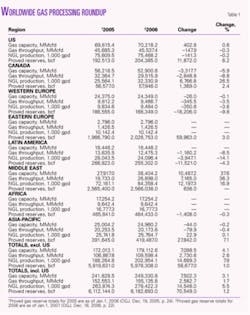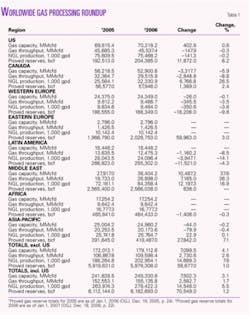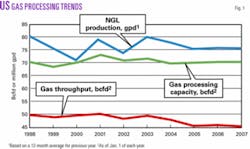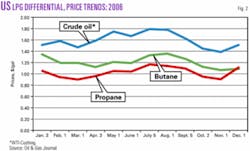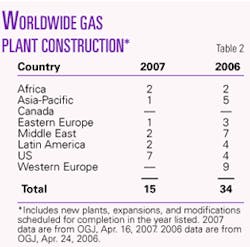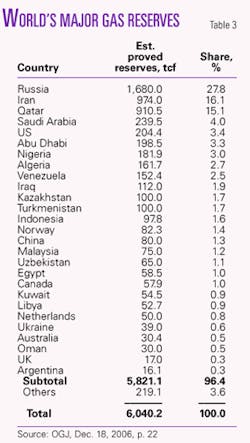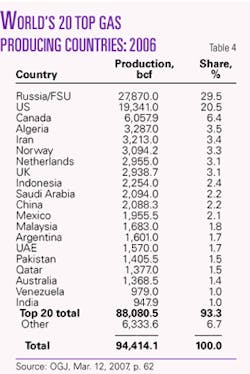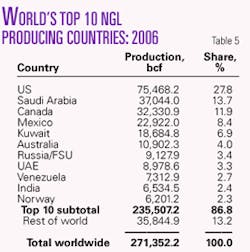Worldwide natural gas production in 2006 increased by less than 2%, with production in major gas processing countries US and Canada advancing by 0.3% and 0.9%, respectively (OGJ, Mar. 12, 2007, p. 62).
It is little wonder, then, that gas processing capacity in the US was essentially flat and in Canada fell nearly 6% from 2005 (Table 1).
For the entire world, new data for Middle East processing, primarily in Iran, corrected and raised earlier Oil & Gas Journal worldwide totals. Gas production for the region, however, showed a drop of nearly 150 bcf, reflecting flat processing capacities for the region’s gas plants.
Worldwide, natural gas processing capacities outside the US and Canada continued to outpace capacities in the world’s two largest gas processing countries, a trend that emerged last year for 2005 data. For 2006, gas-plant capacities in the US and Canada reached slightly less than 50% of world capacity for the second year in a row. That trend was pushed by plants’ capacities in the US dropping by nearly 6%, while Canada’s plants increased capacities by only 0.58%.
Highlights
During 2006, natural gas production increased in all the world’s regions except for the Middle East, OGJ numbers show. But in aggregate, the increases were smaller than seen between 2004 and 2005 (OGJ, June 18, 2006, p. 54). Nonetheless, the tip in gas processing capacity to regions outside the US and Canada that became evident in 2005 remained in 2006.
Much of the new gas production in 2006 went to feed new LNG production capacity in Nigeria and Australia. In 2006, Qatar surpassed Indonesia and Malaysia to become the world’s leading exporter of LNG.
2007 will see yet more LNG capacity come online requiring yet more natural gas capacity: More than 22.5 million tpy of liquefaction capacity will start up this year, pushing world liquefaction capacity up by about 12% to more than 184 million tonnes/year.
New figures available for Canadian NGL production forced an adjustment in 2006 numbers and helped push US and Candian NGL production for the year up to 38.7% of the world totals from slightly more than 33% in 2005, off from more than 34% in 2004, more than 40% in 2003, and 42% in 2002.
Middle East liquids production nonetheless outpaced the US and should continue to grow as countries in the region, especially Saudi Arabia, focus their production activities on more gas and more feedstock for petrochemical production in the region and the Far East.
Adding Mexican data to those for the US and Canada (removing Mexico for the exercise from the Latin America column) reveals that North America holds:
- Only 51.3% of the world’s capacity, down from barely 52% for 2005, from more than 53% for 2004, from 52% in 2003, and off from 54% in 2002 and 55% in 2001.
- 46.9% of the world’s NGL production, under the revised, corrected numbers OGJ has obtained for Canadian production.
As expected in last year’s report, Canadian natural gas production did rebound somewhat in 2006, responding to demand from the country’s rapidly growing heavy-oil production and greater Lower 48 demand. Mexico’s production also continued to rise by more than 190 bcf in 2006
On Jan. 1, 2007, OGJ data show that US gas processing capacity stood at slightly more than 70 bcfd, essentially flat compared with both 2005 and 2004; throughput in 2006 also was flat, averaging a bit more than 45.5 MMcfd, from the 2005 average of more than 46 bcfd; and NGL production, nearly 75,500 gpd, from more than 76 million gpd (Fig. 1), again essentially flat compared with 2005 and 2004.
Fig. 2 shows pricing differentials in the US between LPG-the most widely traded NGL on the world market-and crude oil for the first trading day of each month in 2006. The chart shows the historically normal relationship between LPG and crude oil continued throughout 2006. (An accompanying article, beginning on p. 56, discusses international trade in LPG and ethane and the NGL production implications from the growing LNG trade.)
Sources
Oil & Gas Journal’s exclusive, plant-by-plant, worldwide gas processing survey and its international survey of petroleum-derived sulfur recovery provide industry activity figures.
Canadian data are based on information from Alberta’s Energy and Utilities Board that reflect actual figures for gas that moved through the province’s plants and are reported monthly to the AEUB. For 2000 for the first time, OGJ took these data for all of Alberta and compiled annual figures and thereby created a new baseline for data comparisons thenceforth.
In addition to AEUB figures for Alberta and to operator responses to its annual survey, OGJ has supplemented its Canadian data with information from the British Columbia Ministry of Employment & Investment’s Engineering and Operations Branch and the Saskatchewan Ministry of Energy & Mines.
Gas processing capacity outside Canada and the US as 2007 began stood at 126.2 MMcfd, nearly dead level with capacity for 2005, and up from nearly 115.5 bcfd in 2004; throughput outside Canada and the US for 2006 averaged barely 80 bcfd, down from more than 81 bcfd for 2005, and up from nearly 74 bcfd in 2004; and NGL production in 2006 outside the US and Canada averaged 170 million gpd, down from a 2005 production of more than 201million gpd, and near the 2004 pace of more than 166.5 million gpd.
The current state of gas plant construction in the world appears in Table 2, based on OGJ’s worldwide construction surveys. Table 3 ranks the world’s major natural gas reserves by country at the start of 2007; Table 4, the world’s top natural gas producing countries for 2006; and Table 5, the world’s leading NGL producers.
Activity
What follows is a series of shapshots of gas processing events in the last 15 months.
Europe and elsewhere
In Europe, Statoil ASA, on behalf of state-owned Gassco AS, hired Vetco Aibel to design, build, and install a gas compressor and a condensate train at the Kollsnes gas processing plant near Bergen, Norway (cover photograph).
The 790-million kroner contract extends through the second half of 2008. The Kollsnes plant processes gas from Troll, Kvitebjørn, and Visund fields and moves it through four pipeline systems to continental Europe.
These installations, capable of handling 143 million standard cu m/day of gas, are owned by Gassled and operated by Gassco, with Statoil as the technical service provider.
Elsewhere last year, state-owned Uzbekneftegaz began to build a $63.6-million LPG unit at its gas processing subsidiary Shurtanneftegaz in the Kashkadarya region of Uzbekistan.
Shurtanneftegaz, one of three gas processing companies in Uzbekneftegaz, processes 11 billion cu m/year of gas.
After three stages of construction, the plant will produce 175,000 tonnes/year of propane-butane mix by 2010. The first stage of construction was to be completed by yearend 2006; the unit will reach a capacity of 45,000 tonnes/year.
Uzbekneftegaz said it plans several projects to increase LPG production at the Mubarek gas processing plant and the Shurtan gas production complex.
In Africa, Khalda Petroleum Co. hired Petrofac of London to design and construct a fourth gas-conditioning train at Salam on the Khalda Concession in the western desert of Egypt, according to Apache Corp. Khalda is a joint venture of Apache and Egyptian General Petroleum Corp.
The fourth train and an earlier approved third train will increase total conditioning capacity for production from Apache’s Jurassic gas reserves to 710 MMcfd of gas and 66,000 b/d of condensate.
Each train will be able to process 100 MMcfd of sales gas and 14,000 b/d of sales condensate. The expansions target completion by late 2008.
In Asia, Oil & Natural Gas Corp. of India hired Toyo Engineering Corp. in a ¥20-billion job to build an NGL extraction plant at Dahej in Gujarat state. Due for start-up in 2008, the plant will extract liquids for use as petrochemical feedstock from LNG from Petronet LNG Ltd.’s nearby 5 million tonne/year terminal.
In January 2006, Petronet awarded a ¥30-billion contract to a joint venture of Toyo Engineering Corp., Ishikawajima-Harima Heavy Industries Co., Itochu Corp., and Mitsui & Co. to double capacity of the Dahej LNG terminal.
Elsewhere in Asia, Natural Gas Development Co., a unit of Canadian firm InterOil, Merrill Lynch Commodities, and Clarion Finanz AG, agreed with the government of Papua New Guinea to develop a gas processing plant and gas liquefaction plant.
InterOil, which owns the 32,500-b/d Papua New Guinea refinery in Port Moresby and conducts onshore exploration in the country, has secured a $130 million nonconvertible credit facility, $30 million of which is for the gas projects.
The LNG proposal is for a plant capable of producing as much as 5 million tonnes/year.
North America
In the US last year, Crosstex Energy announced it would invest $130 million to expand its Parker County, Tex., processing plants and gathering systems and build a third plant by yearend 2007. Two other plants are part of a $55 million investing by Crosstex and have total processing capacity of 85 MMcfd. With capacity expansions and the new plant, Crosstex will increase its total processing capacity in Parker County by up to 285 MMcfd.
Earlier this year, Williams announced it had completed and started up the final 200-MMcfd of a second cryogenic unit at its Cameron Meadows gas plant in southern Louisiana. Full design capacity is 500 Mcfd.
The plant was knocked out by Hurricane Rita in Sept 2005. The first of the plant’s two cryogenic processing units came on line in February 2006, making available up to 300 Mcfd.
Total price tag for reconstruction was $35-40 million, according to the company. Early last year in Wyoming, Enterprise Products Partners LP subsidiary Enterprise Gas Processing LLC had bought the Pioneer silica gel natural gas processing plant near Opal from a unit of TEPPCO Partners LP. Purchase price was $38 million.
In the deal, Enterprise purchased TEPPCO’s rights to process natural gas from Jonah and Pinedale fields in southwest Wyoming.
Anticipating greater gas production from Jonah and Pinedale fields, Enterprise embarked on construction to double the gas plant’s processing capacity to 600 MMcfd from 300 MMcfd.
This work joined work on a 650-MMcfd cryogenic natural gas processing plant next to the silica gel plant. Expansion of the silica gel plant was completed last year; the new cryogenic plant is to be in service by fourth-quarter 2007. Earlier, Enterprise had said that, at full capacity, the cryogenic plant would have the flexibility to switch from conditioning mode to full recovery, able to recover 2,500-30,000 b/d of NGL.
NGL from the new cryogenic processing plant will move through Enterprise’s Mid-America Pipeline and Seminole Pipeline systems that extend from the Rockies to the Texas Gulf Coast and will be fractionated at Enterprise’s fractionators in Hobbs, Tex., also under construction, or at the partnership’s complex in Mont Belvieu.
Offshore, Enterprise Products Partners LP, Houston, and Atwater Valley Producers Group have teamed up to increase the processing capacity at the Independence Hub platform in the eastern deepwater Gulf of Mexico by 150 MMcfd to 1 bcfd.
The deep-draft semisubmersible platform was floated out last year to its site on Mississippi Canyon Block 920 in 8,000 ft of water, where it will process gas from 10 fields.
The $28-million expansion project includes increasing, by the same amount, the transportation capacity of the Independence Trail natural gas pipeline, which will transport the gas to the Tennessee Gas Pipeline system in West Delta Block 68.
In Canada, Inter Pipeline Fund, Canada, invested C$36 million to increase ethane production at the Empress V plant, where Inter Pipeline is half owner. The work will hike ethane production by about 45%, or 7,000 b/d. Construction began earlier this year with first volumes coming second-quarter 2008.
In Mexico, Pemex announced in early 2007 that it will build two new gas plants for production form the Burgos basin in northeastern Mexico. Investment will reach $276 million. Building the plants will be by a joint venture of Mexico’s Empresas Ica and Fluor Corp. called ICA Fluor. The first plant is due on stream by June 2008; the second in Oct 2008. Each plant will process 200 MMcfd, raising output capacity at the Reynosa complex to 1.2 bcfd.
Sulfur production
Worldwide refining and natural gas processing’s production of petroleum-derived sulfur in 2006 continued to slide, to 84.2 million tonnes/day from slightly less than 85 million tpd in 2005 and from just more than 85 million tpd in 2004. Capacity increased slightly to 178.5 million tpd from slightly more than 178 million tpd in 2005.
Canada and the US continued to dominate last year with 46.9% of processing capacity, a slip from 47% in 2005, and 48.6% of actual production, from 49% for 2005. Both figures continue a decline from 2004.
Canada produced 23.3 million tpd in 2006, nearly even with 23.4 million tpd in 2005, down slightly from 2004. US production in 2006 continued to slip, to more than 17.6 million tpd from slightly more than 18.5 tpd in 2005.
Canada last continued to account for less than 24% of the overall total capacity and more than 27.6% of production, nearly even with 27.5% in 2005.
Click here to download the Worldwide Gas Processing table (PDF) from page 55.
OGJ subscribers can download, free of charge, the 2007 Worldwide Gas Processing Survey tables at www.ogjonline.com: Click on Resource Center, Surveys, OGJ Subscriber Surveys, then Worldwide Gas Processing, and choose from the list below June 18, 2007. To purchase spreadsheets of the survey data, please go to http://www.ogj.com/resourcecenter/orc_survey.cfm or email [email protected].
Click here to download the 2007 Worldwide Gas Processing Survey (PDF)
Click here to download the 2007 World Sulfur Production Survey (PDF)
